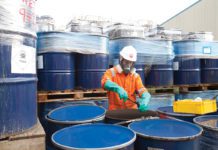
Last year Scotland generated its lowest amount of household waste since 2011, according to the latest figures released by the Scottish Environment Protection Agency (SEPA), published on 17 October. The same data reveal a meagre 0.3 percentage point increase in recycling levels on the previous year.
The figures provide detail of Household Waste collected across all Local Authorities during 2022, as well as waste landfilled and incinerated in Scotland in 2022. And it suggests a return to something more like normality, after the anomalous years of 2020 and 2021, which were impacted by restrictions.
Scottish households generated the equivalent of 0.43 tonnes of waste per person in 2022, with 0.19 tonnes recycled, 0.11 tonnes sent to landfill and 0.14 tonnes diverted through other means, such as incineration.
The total amount of household waste generated was 2.33 million tonnes, a decrease of 148,000 tonnes (6.0%) from 2021. Of this, 43.3% was recycled, a 0.3 percentage point increase from 2021. The recycling figure includes recycling and reuse (657,000 tonnes) and composting (355,000 tonnes). You can view the household waste statistics in more detail here.
Carbon impact of Scottish households
The carbon impact of Scottish household waste generated and managed in 2022 was 5.5 million tonnes of carbon dioxide equivalent, which equates to 1.02 tonnes of CO2e per person. This was a decrease of 6.1% (357,000 tonnes CO2e) from 2021.
As SEPA explained, this Scottish carbon metric measures the whole-life impact of resources. ”A measure of national performance, the metric takes a holistic view, from resource extraction and manufacturing emissions, through to waste management emissions. This is measured in carbon dioxide equivalent (CO2e).”
Waste sent to landfill continues to decrease
Scottish household waste landfilled in 2022 was 585,000 tonnes, a decrease of 78,000 tonnes (11.7%) from 2021. This continues the long-term downward trend, with a reduction of 868,000 tonnes (59.7%) of household waste landfilled since 2011.
In 2022, Scotland landfilled 25.1% of the waste generated, down 30.7 percentage points from 2011 when the figure was 55.8%. This comparison allows for the variation in the amount of waste generated.
Waste recycled and diverted from landfill
The 2022 recycling rate was 43.3%, up 0.3 percentage points from 2021 and an increase of 3.8 percentage points from the 39.6% achieved in 2011.
The majority was recycled or reused (657,000 tonnes, 65%), with composting contributing the remaining 355,000 (35%).
The amount of household waste managed by other diversion from landfill was 736,000 tonnes, a decrease of 15,000 tonnes (1.9%) from 2021. Most was managed by incineration (604,000 tonnes, 82.0%).
What Scotland is recycling – plastic and textiles up, glass and construction & soils down
The largest material category recycled or reused in 2022 was paper and cardboard (181,000 tonnes, 27.6%). There was a decrease of 2.7% for these materials recycled or reused between 2021 and 2022, which fits with the longer-term downward trend for paper and cardboard, which is down 59,000 tonnes (24.6%) from 2011.
Of the seven material categories that comprised the highest amount of waste recycled or reused, plastic wastes showed the largest increase (up 3,000 tonnes, 4.2%) followed by textiles (an increase of 2,000 tonnes, 19.0%).
The largest reductions were glass (a decrease of 10,000 tonnes, 8.1%) followed by construction and soils (a decrease of 9,000 tonnes, 8.6%).
Waste from all sources landfilled and incinerated
Also published on 17 October were statistics providing the details of waste landfilled and incinerated in Scotland for calendar year 2022. The corresponding data set for all waste generated and recycled in Scotland during 2022 will be published in March 2024.
Total waste landfilled in Scotland
The total quantity of waste landfilled in Scotland in 2022 was 2.4 million tonnes, a decrease of 631,000 tonnes (21.0%) from 2021. This continues a long-term trend, with a reduction of 4.7 million tonnes (66.4%) since 2005, and is the lowest annual amount on record of waste landfilled since then.
Most of the decrease was due to a reduction in sorting residues (down 311,000 tonnes or 32.2%) and soils (down 274,000 tonnes or 29.5%). The reduction follows an increase in the landfilling of these wastes in 2021, due to a resumption of economic activity in Scotland following extended lockdowns and other restrictions due to Covid-19.
The amount of biodegradable municipal disposed to landfill in 2022 was 707,000 tonnes, a decrease of 174,000 tonnes (19.8%) from 2021 and a reduction of 1.3 million tonnes (65.3%) since 2005. For more detail on all waste landfilled, visit SEPA’s website here.
Waste incinerated in Scotland
The total quantity of waste incinerated in Scotland in 2022 was 1.42 million tonnes, an increase of 67,000 tonnes (4.9%) from 2021. Sorting residues made up over a third (34.7%) of this (492,000 tonnes, up 42,000 tonnes – 9.4%).
Over one third (36.4%) of waste incinerated was incinerated by recovery. This follows the accreditation of an additional two municipal waste incineration facilities to the R1 efficiency standard in 2022, bringing the total number of accredited facilities in Scotland to three. For more detail on all waste incinerated, visit SEPA’s website here.
David Harley, Interim Chief Officer, Circular Economy, said: “Scotland is ambitious for a more circular economy where fewer resources are disposed of and much more are re-used and recycled, creating a range of environmental, economic and societal benefits. We’ve all got a role to play, from the making choices about the resources we use, to how we re-use and recycle – and what we dispose of.
“At SEPA we’re working closely with Scottish Government, Zero Waste Scotland and Scottish councils to help improve recyclate quality and support Scottish waste infrastructure – these statistics are an important measure of Scotland’s progress towards a circular economy.








